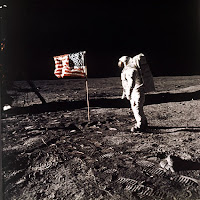Neil Armstrong's 'giant leap for mankind' as he set foot on the lunar surface in 1969 climaxed a monumental achievement in human history. Despite his fame, the former fighter pilot shrank from the spotlight and called himself a 'nerdy engineer.'
By Valerie J. Nelson and Eric Malnic
When Neil Armstrong became the first person to set foot on the moon, on July 20, 1969, he uttered a phrase that has been carved in stone and quoted across the planet: "That's one small step for man; one giant leap for mankind."
The grainy black-and-white television images of him taking his first lunar stroll were watched by an estimated 600 million people worldwide — and firmly established him as one of the great heroes of the 20th century.
Armstrong, who had heart surgery in early August, died Saturday in Cincinnati at 82, said NASA spokesman Bob Jacobs. The cause was complications from cardiovascular procedures, his family announced.
For the usually taciturn Armstrong, the poetic statement was a rare burst of eloquence, a sound bite for the ages that only increased his fame. He was never comfortable with celebrity he saw as an accident of fate, for stepping on the moon ahead of fellow astronaut Edwin "Buzz" Aldrin. The reticent, self-effacing Armstrong would shun the spotlight for much of the rest of his life.
In a rare public appearance, in 2000, Armstrong cast himself in another light: "I am, and ever will be, a white-sock, pocket-protector, nerdy engineer."
History would beg to disagree.
In a statement, President Obama said that when Armstrong stepped on the moon, "he delivered a moment of human achievement that will never be forgotten."
 And when Armstrong and his two fellow crew members lifted off from Earth in Apollo 11, "they carried with them the aspirations of an entire nation," Obama said. "They set out to show the world that American spirit can see beyond what seems unimaginable — that with enough drive and ingenuity, anything is possible."
And when Armstrong and his two fellow crew members lifted off from Earth in Apollo 11, "they carried with them the aspirations of an entire nation," Obama said. "They set out to show the world that American spirit can see beyond what seems unimaginable — that with enough drive and ingenuity, anything is possible."NASA administrator Charles Bolden spoke for many when he said, "As long as there are history books, Neil Armstrong will be included in them."
"Besides being one of America's greatest explorers, Neil carried himself with grace and humility that was an example to us all," Bolden said in a statement.
In the years that followed the flight of Apollo 11, Armstrong was asked again and again what it felt like to be the first man on the moon. In answering, he always shared the glory: "I was certainly aware that this was the culmination of the work of 300,000 to 400,000 people over a decade."
Yet how many other self-proclaimed nerdy engineers flew 78 combat missions as a Navy fighter pilot during the Korean War? Logged more than 1,000 hours as a test pilot in some of the world's fastest and most dangerous aircraft? Or became one of the first civilian astronauts and commanded Apollo 11, the first manned flight to land on the moon?
His biographer, James R. Hansen, called Armstrong "one of the best-known and least-understood people on the planet."
When asked to describe the astronaut in just a few words, Hansen told Ohio's Columbus Dispatch in 2005 that Armstrong was "stoic, self-controlled, dedicated, earnest, hardworking and honest."
Neil Alden Armstrong was born Aug. 5, 1930, on his grandfather's farm near Wapakoneta, Ohio, and had a happy and conventional upbringing.
His civil servant father, Stephen Armstrong, audited county records in Ohio and later served as assistant director of the Ohio Mental Hygiene and Corrections Department. The family of his mother, Viola, owned the farm.
For more than a decade, his family moved around Ohio to accommodate his father's job before settling down in Wapakoneta.





No comments:
Post a Comment